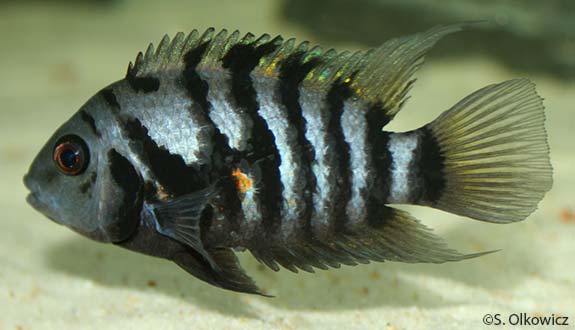

Alternative species (click on the thumbnail to see the card)
Names
Scientific name
Amatitlania nigrofasciata
Heros nigrofasciatus
Archocentrus nigrofasciatus
Cichlasoma nigrofasciatum
Cryptoheros nigrofaciatus
Common name
Convict cichlid
Zebra cichlid
Blaukehlchen (DE)
Zebrabuntbarsch (DE)
Grünflossenbuntbarsch (DE)
Origin

Origin: central America
Biotope: American
Dimorphism

The female is much smaller than the male. It is also more colorful, with shades of red on the belly, that the male does not have. The male has a nuchal bump.
Group
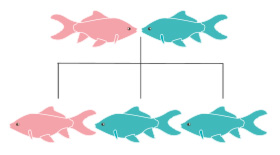
Cichlidae
Volume

Couple: 120 L / 26 imp gal / 32 US gal
Community: 450 L / 100 imp gal / 120 US gal
Parameters

T°: 22 to 28°C or 72 to 82°F
pH: 7 to 8
Hardness: 10 to 20°dGH
Difficulty

Average
Size

8 to 12 cm (3 to 5")
Longevity

10 years
Living zone
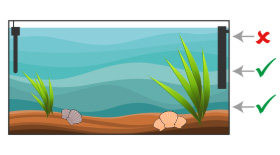
Middle and Depth
Individuals
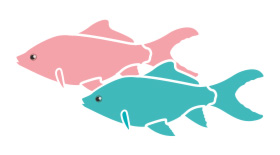
2 (couple)
Food
How to feed the Convict cichlid?
Food
How to feed the Convict cichlid?
Like many omnivorous fish, this species is not very difficult to feed. For a good health, vary its meals as much as possible between meat and vegetable foods. Being a lively and fertile fish, they spend a lot of energy: they are therefore very voracious! Distribute enough food to satisfy them.
For the meat portion, choose fresh or frozen foods. For the vegetal part, propose spinach, salad...
You can also distribute traditional dry foods as a supplement.
Behavior
What kind of behavior does the Convict cichlid have?
Behavior
What kind of behavior does the Convict cichlid have?
Like many cichlids, this species is territorial. This temperament gets worse during the breeding season when the couple will defend their eggs against anyone who approaches a little one too close. In general, it is very aggressive, both with other species and members of its own species.
It spends most of its time in the lower part of the aquarium, searching the substrate for food. It is lively and active.
Cohabitation
Who can live with the Convict cichlid?
Cohabitation
Who can live with the Convict cichlid?
Nigros must live as a couple, it’s the minimum required. We can satisfy them with a specific aquarium of 120 liters or 26 Imp Gal or 32 US Gal.
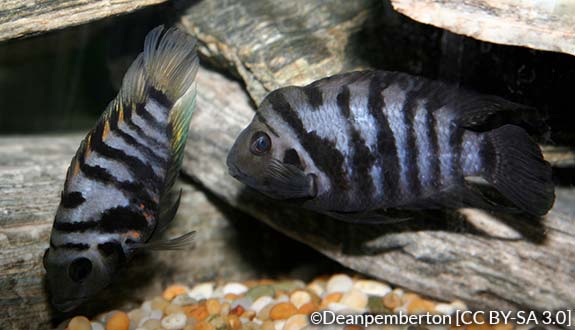
For a greater number of fish, or for a community aquarium, it will be necessary to have at least 450 liters or 100 Imp Gal or 120 US Gal (even 600 liters or 130 Imp Gal or 160 US Gal according to the species you are considering). Indeed, Nigros share their living area with difficulty and can become very aggressive if the aquarium is too small. In groups, take 5 or 6 young fish regardless of size. For other species, choose robust, combative (non-territorial if possible) fish to balance temperaments. Indeed, species too shy or too weak will be eliminated, even if the fish are twice the size of Nigro. In any case, keep in mind that cohabitation can potentially degenerate and you will need to intervene to isolate certain fish.
Attention to the association with other Amatilanias because there are risks of hybridization between these species.
Breeding
How to breed the Convict cichlid?
Breeding
How to breed the Convict cichlid?
Breeding of this species is very easy! No particular protocol needs to be followed: breeding is spontaneous if your fish are in good health. You can have up to one laying per month.
A couple ready to spawn changes color: the female becomes slightly red, and the male intensifies its colors. The laying is deposited in a cavity, on a flat stone, where the couple can also dig a hole under a rock (beware of the risk of landslide, see "Its aquarium"). The brood has between 100 and 150 eggs that will incubate about 48 to 72 hours (depending on temperature). The couple takes care of their little ones: the female ventilates and watches the eggs. The male goes to defend fiercely the place of laying and can be very combative during this period. Once born, and after resorption of the yolk sac, the fry begin to swim freely. The two parents will then work together to defend the virulent "cloud of fry", and will gather them tirelessly. They can sometimes put them in their mouth to protect them. Some parents will be alert until the fry are subadult and out of danger of predation. It's a beautiful show not to miss!
Without predators, the fry survival rate is pretty good. Given this good performance, be careful not to be overwhelmed by all these young fish!
After a month, young fish are already identical to adults: they search the sand for food, have their color and their character!
Fry food: finely chopped strawberries, Artemia nauplies... Note that parents are able to feed their offspring by grinding the food you give them!
Its aquarium
Which aquarium for the Convict cichlid?
Its aquarium
Which aquarium for the Convict cichlid?
In their natural environment, these are fish that live in a rather congested setting, and always under cover. The water is fast and well oxygenated.
In aquariums, propose a mainly rocky decoration. The arrangement of the stones must form caves and hiding places for the Nigros. Ideally, a layout imitating a cave would be perfect! Pay attention to the stability of your decoration to avoid the risks of landslide with these big diggers (install your rocks BEFORE putting the sand, and stick the elements between them if necessary). Fill in with some big roots. Anyway, know that the Nigro is at home in your aquarium, and it is perfectly capable of redoing the decor to its taste! Finally, when you compose the rocky environment of your aquarium, think about constituing territories, distinct and satisfactory for all the species which you plan to make coexist: you will limit the risks of disputes for the best place. To separate the territories, use the roots, plants or any other element visually separating the different areas of life.
For the plants, even though Nigro appreciates the presence of many plants, it uproots many plants as it searches the soil. The best is either to ballast the plants that you’ll install in the ground, or to fix them to the decor. The Anubias will be useful. In all cases, choose very robust plants (Vallisneria, Cryptocoryne ...)! Floating plants are also welcome.
For the bottom of the aquarium, you will choose a non-cutting sand soil. Put some pebbles or rocks to complete the decor.
For the filtration, opt for a filtration powerful enough, because this fish likes a medium current and well oxygenated water. The water parameters are not very important for the species, and the maintenance in most of the waters is very suitable.
Good To know
Find all additional information!
Good To know
Find all additional information!
There are different chromatic variants due to breeding selections: gold, pink, albino...
As the years go by, the male presents a lump on the head (called nuchal bump) which grows according to its age.
Very easy to maintain, very solid and tolerant with regard to water parameters, this fish can be perfectly maintained by novice aquarists, as long as they take into account its aggressive nature.
Scientists discovered, for the first time in 2019, signs of attachment within a couple Amatitlanias (Amatitlania siquia): "Such emotional attachment to the partner is one of the first criteria defining romantic love, which is generally considered proper to our species. Yet this study, published in Proceedings of the Royal Society B: Biological Sciences 20190760, suggests that romantic love may be a feeling found in other species as well. To learn more (only in French): https://inee.cnrs.fr/fr/cnrsinfo/peine-de-coeur-dans-laquarium-le-chagrin-damour-rend-les-poissonspessimistes. It also seems that they are making efforts within the couple to adapt to each other, changing their initial behavior to adapt to their partner!
Yours photos!

By Encyclo-Caro
Comments
Sort by:
Please login to post comments
